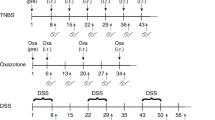Summary
Animal model systems have been used extensively to study both experimental and naturally occurring ulcerative colitis syndromes. Interestingly, despite a variety of different animal species and a broad range of inducing agents, the response of the large intestine has been somewhat predictable. Although there is suggestive evidence for transmissible agents in several of these animal model systems, documentation of a bacterial or viral etiology has remained elusive. Perhaps the best evidence to suggest that bacteria play a role in the development of naturally occurring ulcerative colitis resides in the studies utilizing the rabbitdinitrochlorobenzine model and the carrageenininduced ulcerative colitis model in the guinea pig, The evidence for microbial involvement in these model systems includes the use of single bacterial species in the carrageenin model to produce an ulcerative colitis like disease and the use of antimicrobial agents to alter the experimental model system in the guinea pig and hamster with proliferative ileitis and evidence of transmissibility. Recent reports of transmissible agents for both ulcerative colitis and Crohn's disease in studies utilizing immunologically deficient mice also suggest that the search for the “agent” and mechanism should continue in model systems.
The many differences between animal model systems and the human disease cannot be ignored. These differences make establishing what appears to be a complicated etiology even more difficult. Despite the difference in anatomy, physiology, and nutritional factors between animal model systems and the human disease process, the fact remains that one or more of these model systems may reflect the same mechanism or etiologic agent which occurs in the human disease. It is important that future studies include animal model systems, regardless of whether or not they absolutely reflect all of the requirements of the naturally occurring disease.
Similar content being viewed by others
References
Van Kruningen HJ: Granulomatous colitis of boxer dogs: Comparative aspects. Gastroenterology 53:114–122, 1967
Van Kruningen HJ: Canine colitis comparable to regional enteritis and mucosal colitis of Man. Gastroenterology 62:1128–1142, 1972
Rooney JR, Brayans JT, Poll ER: Colitis “X” of horses. J Am Vet Med Assoc 142:510–511, 1963
Blood DC, Henderson JA, Radostits OM: Veterinary Medicine, 5th ed., Philadelphia, Lea and Febiger, 1979, p 1062
Emsbo P: Terminal or regional iletis in swine. Nord Vet Med 3:1–28, 1981
Gillespie JH, Timoney JF (eds.): Hagen and Bruner's Infectious Diseases of Domestic Animals, 7th ed. Ithaca, New York, Comstock Publishing Associates, Cornell University Press, 1981, pp 71–73
Amend NK, Loeffler DG, Ward BC, Van Hoosier GL: Transmission of enteritis in the Syrian hamster. Lab Anim Sci 26:566–572, 1972
Boothe AD, Cheville NF: The pathology of proliferative ileitis of the golden hamster. Pathol Vet 4:31–44, 1967
Jackson ST, Proliferative ileitis in Syrian hamsters (Mesocricetus auratus). Lab Anim Sci 6:12–15, 1970
Frisk CS, Wagner JE: Experimental hamster enteritis. An electron microscopic study. Am J Vet Res 38:1861–1868, 1977
Jonas AM, Tomita Y, Wyand S: Enzootic intestinal adenocarcinoma in hamsters. J Am Vet Med Assoc 147:1102–1108, 1968
Jacoby RO, Osbaldiston GW, Jonas AM: Experimental transmission of atypical ileal hyperplasia of hamsters. Lab Anim Sci 25:465–473, 1975
Marcus R, Watt J: Seaweeds and ulcerative colitis in laboratory animals. Lancet 2:489–490, 1969
Watt J, Marcus R: Carrageenin-induced ulceration of the large intestine in the guinea pig. Gut 12:164–171, 1971
Onderdonk AB, Bartlett JG: Bacteriologic studies of experimental ulcerative colitis. Am J Clin Nutr 32:285–289, 1979
Onderdonk AB, Hermos JA, Dzink JL, Bartlett JG: Protective effect of metronidazole in experimental ulcerative colitis. Gastroenterology 74:521–526, 1978
Grasso P, Sharrat M, Carpanini FMB, Gangolli SD: Studies on carrageenin and large bowel ulcerations in mammals. Food Cosmet Toxic 11:555–564, 1973
Bonfils S: Carrageenin and the human gut. Lancet 2:414, 1970
Onderdonk AB, Franklin ML, Cisneros RL: Production of experimental ulcerative colitis in gnotobiotic guinea pigs with simplified microflora. Infect Immun 32:225–231, 1981
Onderdonk AB, Cisneros RL, Bronson RT: Enhancement of experimental ulcerative colitis by immunization withBacteroides vulgatus. Infect Immun 42:783–788, 1983
Dupont HL, Formal SB, Hornick RB: Pathogenesis ofEscherichia coli diarrhea. N Engl J Med 285:1–9, 1971
Staley TE, Corley LD, Jones EW: Early pathogenesis of colitis in neonatal pigs monocontaminated withEscherichia coli. Am J Dig Dis 15:923–935, 1970
Prohaska J: Development and fate of experimentally induced enteritis. Gastroenterology 51:913–924, 1966
Rachmilewitz D (ed): Inflammatory Bowel Diseases. The Hague, Netherlands, Nijhoff, 1982, pp 41–56, 80–95
Mitchell DN, Rees RJW: Agent transmissible from Crohn's disease tissue. Lancet 2:168–171, 1970
Kirsner JB, Elchlepp JG, Goldgraber MD: Production of an experimental ulcerative colitis in rabbits. Arch Pathol 68:392–408, 1959
Kraft SC, Fitch FW, Kirsner JB. Histologic and immunohistochemical features of the Auer colitis in rabbits. Am J Pathol 43:913–927, 1963
Richardson GS, Leskowitz S: An attempt at production of autoimmunity to tissue of the gastroentestinal tract. Proc Soc Exp Biol Med 106:357–359
Rabin BS, Rogers SJ: A cell-mediated immune model of inflammatory bowel disease in the rabbit. Gastroenterology 75:29–33, 1978
Bicks RO, Rosenberg EW: A chronic delayed hypersensitivity reaction in the guinea pig colon. Gastroenterology 46:543–549, 1964
Kirsner JB, Shorter RG (ed): Inflammatory Bowel Disease. Philadelphia, Lea and Febiger, 1975, pp 23–36
Author information
Authors and Affiliations
Rights and permissions
About this article
Cite this article
Onderdonk, A.B. Experimental models for ulcerative colitis. Digest Dis Sci 30, 40S–44S (1985). https://doi.org/10.1007/BF01296973
Issue Date:
DOI: https://doi.org/10.1007/BF01296973




